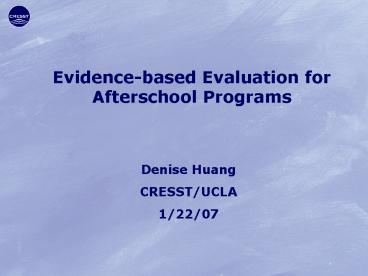Evidence-based Evaluation for Afterschool Programs - PowerPoint PPT Presentation
1 / 18
Title:
Evidence-based Evaluation for Afterschool Programs
Description:
Evidence-based Evaluation for Afterschool Programs. Denise Huang. CRESST/UCLA. 1/22/07 ... Evidence based training approach (CASEL) ... – PowerPoint PPT presentation
Number of Views:54
Avg rating:3.0/5.0
Title: Evidence-based Evaluation for Afterschool Programs
1
Evidence-based Evaluation for Afterschool
Programs
- Denise Huang
- CRESST/UCLA
- 1/22/07
2
In the Beginning.
- after school programs were available to students
at a much smaller scale - The purpose is mainly to provide monitoring
- The opportunities for students to engage in
enrichment activities - In the 90s, the concepts of safe haven for
at-risk youths
3
No Child Left Behind Act (2002)
- An emphasis is placed on schools to improve
academic achievement, particularly for students
at risk - Schools that are not performing well can use
after school programs as supplemental services to
improve student performance - More funding becomes available, both from the
government and private sector - For the last 3 years, the 21st Community Learning
Center is working with a budget of over 1 billion
4
The Formation of Afterschool Alliance
- A partnership between DOE and Mott Foundation
- A coalition of public and private organizations
- Dedicated to raise awareness of the importance of
ASP and advocating on their behalf - The goal is to make quality ASP available to all
children by 2010
5
The Need of Evidences to Support Expansions
- Do afterschool programs contribute to positive
youth development? - What aspects of the program functioning
contribute to these positive outcomes?
6
Indicators for program effectiveness
- Student attendance in regular school
- Performance measures (achievement tests, homework
completion, classroom grades, language
re-designation, school retention, future
aspirations, etc.) - Non-cognitive measures (safety, attitudes towards
school, relationships with adults, social
competence, conflict resolution skills,
self-esteem, and self-efficacy etc.) - Parent involvement
- Professional development
- Long-term effects (drop out rate, life
satisfaction, etc)
7
What is known about the impacts of ASP?
- Tutoring and academic
- Inconclusive
8
Personal and Social Outcomes
- Findings in general positive
- concerns about safety
- conflict resolution
- academic self-efficacy
- study habits
- family involvement
- future aspirations
9
Long-term Outcomes
- Long-term effect study
- Dropout study
- DOJ study
10
Who Benefited Most
- Students who attended more regularly
- Female students
- LEP students
- Students who scored low initially on attitudinal
surveys (self-efficacy, work habits, conflict
resolution skills) - Students with low performance in test scores
11
Summary of Effects from Current Meta-analyses
- Youth who participated in quality ASP improved
significantly in feelings and attitudes towards
self and learning - Positive social behaviors
- Academic improvements
- Reduce gang participation and criminal behavior
12
What practices are effective in producing student
outcomes?
- Moving away from a deficit model
- Emphasizing social capital, setting features,
networking, collaboration, cooperation - Purposeful staff development
- Active learning and student participation
13
Ecological ModelAfterschool programs are social
organizations embedded with cultural values
coming from families, school, and neighborhood
climate and norms.
Community/Neighborhood
School
LAs BEST
Family
Child
Space / Community / Culture
(structure/resources)
(networks) (social, norms,
sanctions)
14
Provisional Features of Positive Developmental
Settings (Larson et. al)
- Physical and Psychological Safety
- Clear and consistent structure
- Supportive relationships
- Opportunities to belong
- Positive social norms
- Support for efficacy and mattering
- Opportunities for skill building
- Integration of family, school, and community
efforts
15
Developmental Assets (Search Institute)
Asset In Practice
Support School and other activities provide caring, encouraging environments for children
Empowerment Children are given useful roles at home and in the community
Boundaries and Expectations Schools provide clear rules and consequences
Constructive Use of Time Children participate in music, art and other creative activities at least three hours a week
Commitment to Learning Teachers encourage children to explore and engage in stimulating activities
Positive Values Children are encouraged to help others
Social Competencies Children begin to learn how to make choices at appropriate developmental levels
Positive Identity Children are hopeful about their personal future
16
High Scope Educational Research Foundation
- Points of service assessments
- Safe Environment
- Supportive Environment
- Interaction
- Engagement
17
Evidence based training approach (CASEL)
- Sequenced - a sequenced set of activities to
achieve skill objectives - Active - the use of active forms of learning
- Focused program component to be focused on
specific skills - Explicit the targeting of specific skills
18
Evidence Based Evaluation Model
Climate Psychological Safety Clear Consistence
Structure
Staff Philosophy
Shared control
Autonomy Oriented Settings
Shared control
Student choices
Critical voice
Interaction Positive Social Norm Supportive
Relationship Opportunity to belong
Active participants
Personal relevance
Use of materials
Staff Practices
Student negotiation
Classroom structure
Networks Integration of school, family
community efforts
Lifelong learning
Interaction style































